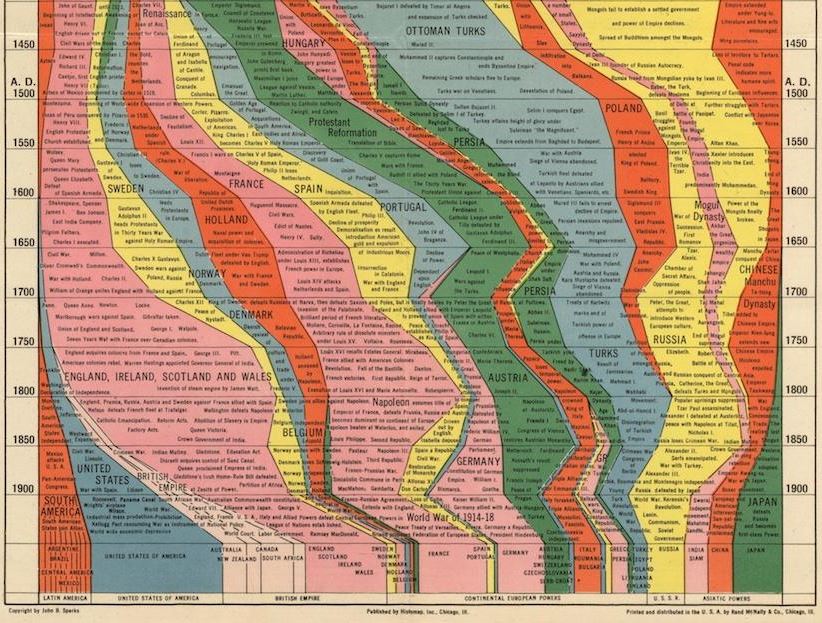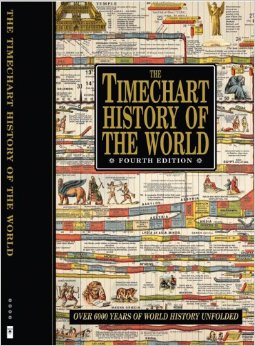by Lisa Cooke | Jan 7, 2014 | 01 What's New, History, Maps

Partial image of Histomap of World History from Slate.com.
This might be the single most ambitious publication EVER: a chart that lays out the history of human civilization. It’s the ultimate infographic, created long before the era of the infographic!
What you see here is a partial image, a screenshot taken from a cool article on the 1931 Histomap: Four Thousand Years of World History.
It’s not perfectly accurate, it carries some cultural biases and ignorance of much of Africa’s rich history and the dates are given more as a range than anything. So what makes this a useful tool for genealogists?
We’re always looking for historical context: a way to understand how our ancestors fit into the “big picture” of history. Are you learning about a Portuguese or French line in your family? Learning by DNA tests that you have some deep Asian roots? Find these categories displayed on the map along with other dominant (or not-so-dominant) groups of your ancestor’s era. It’s cool to look at! Check out the entire map (and an explanatory post in this post by Rebecca Onion at Slate.com.
 Genealogy Gems Contributing Editor Sunny Morton owns a book with a similar chart in it: Timechart History of the World (Timechart series)
Genealogy Gems Contributing Editor Sunny Morton owns a book with a similar chart in it: Timechart History of the World (Timechart series)
The Timechart History of the World. The oversize, double-sided stiff cardboard pages fold out to more than 30 feet of full-color Victorian-decorated timecharts. She highly recommends it for the coffee table, if your coffee table is big enough to handle it!
Bonus: The Huffington Post has a neat article (with a photo) of another map from this series,The Histomap of Religion. (Time Chart of World Religion: A Histomap of Faith Through the Ages ) Religions can be tough to trace forward over time, as various sects divide or merge. Every tool helps!
) Religions can be tough to trace forward over time, as various sects divide or merge. Every tool helps!
by Diahan Southard | Oct 24, 2014 | 01 What's New, Ancestry, DNA, Jewish
 Ancestry.com has improved the ability of AncestryDNA to find good matches for Jewish, Hispanic and other ancestries that maybe weren’t so precise before. Here’s the lowdown, quoted liberally from Ancestry.com’s press release:
Ancestry.com has improved the ability of AncestryDNA to find good matches for Jewish, Hispanic and other ancestries that maybe weren’t so precise before. Here’s the lowdown, quoted liberally from Ancestry.com’s press release:
The problem: Predicting genetic relatives among customers of Jewish and Hispanic descent and some other groups. “In DNA matching, we are looking for pieces of DNA that appear identical between individuals,” says the release. “For genealogy research we’re interested in DNA that’s identical because we’re both descended from a recent common ancestor. We call this identical by descent (IBD). This is what helps us to make new discoveries in finding new relatives, new ancestors, and collaborating on our research.”
“However, we also find pieces of DNA that are identical for another reason. At one extreme we find pieces of DNA that are identical because it is essential for human survival. At the other, we find pieces of DNA that are identical because two people are of the same ethnicity. We call these segments identical by state (IBS) because the piece of DNA is identical for a reason other than a recent common ancestor. This, we have found, often happens in individuals of Jewish descent.”
“The challenge in DNA matching is to tease apart which segments are IBD, and which ones are IBS….Most Jewish customers find that we predict them to be related to nearly every other Jewish customer in the database….Detecting which cousin matches were real and which ones were bogus has always been a challenge for these populations.”
First step toward a solution: “By studying patterns of matches across our more than half a million AncestryDNA customers, we found that in certain places of the genome, thousands of people were being estimated to share DNA with one another–likely a hallmark of a common ethnicity. Our scientific advancements… have allowed us to effectively “pan for gold” in our matches–by throwing out matches that appear to only be IBS, and keeping those that are IBD.”
“While the problem was more pronounced in customers of Jewish and some Hispanic descents, we observed this problem across all ethnic groups. So, all customers will see increased accuracy of their DNA matches, and significantly fewer ‘false’ matches.”
AncestryDNA results with better matches found by this method “will be available in the coming months,” says the release. They plan to email existing customers when results are ready.
by Lisa Cooke | Feb 18, 2014 | Family History Library, Family History Podcast, FamilySearch

Listen to the Family History: Genealogy Made Easy podcast by Lisa Louise Cooke. It’s a great series for learning the research ropes and well as refreshing your skills.
Originally published 2009 Republished February 18, 2014
https://lisalouisecooke.com/familyhistorypodcast/audio/fh19.mp3
Download the Show Notes for this Episode
Welcome to this step-by-step series for beginning genealogists—and more experienced ones who want to brush up or learn something new. I first ran this series in 2008-2009. So many people have asked about it, I’m bringing it back in weekly segments.
Episode 19: Using Family History Centers, Part III
This is the final episode of a series in which we answer all your questions about Family History Centers. My very special guest is Margery Bell, Assistant Director of the Oakland Family History Center in Oakland, California. She has over 35 years of experience working in Family History Centers, and is the perfect choice for our audio guided tour. In our first segment we’re buy prescription medicine online going to talk about the educational opportunities available through the Family History Centers, including the new online Wiki. Then in our second segment, Margery will give you her Top 7 Tips for getting the most out of your visit to a Family History Center (click to the show notes, above, for those tips). Finally, Margery will inspire you with some stories of genealogical serendipity that she has experienced over her many years working at Family History Centers.
Links/Updates
Some Family History Centers are now called FamilySearch Centers. Many Centers have opened in public and private libraries in the past few years, not just in meetinghouses of the Church of Jesus Christ of Latter-day Saints. Click here to find a FamilySearch Center/Family History Center near you.
FamilySearch Research Outlines
FamilySearch Wiki
by Lisa Cooke | Nov 23, 2013 | 01 What's New, British, FamilySearch, Immigration, Irish, Records & databases

By S.MacMillen (Own work) [CC0], via Wikimedia Commons.
The time period covered by these indexes includes an enormous wave of immigrants, mostly from southern and Eastern Europe. Italians, Portuguese, Russians (including Jews), Poles, Slavs and more entered the U.S. by the millions. Record content varies, but may include ports of departure and entry, age, birthplace, gender, marital status, occupation, citizenship or last country of resident, contact information for loved ones in the Old World or in the U.S., intended destination, and even a physical description. Images of the actual record can be viewed.
Also new at FamilySearch are nearly 1.5 million indexed records from the Mexico, Distrito Federal, Civil Registration, 1832-2005, collection and over half a million indexed records from the Hungary Catholic Church Records, 1636-1895, collection. See the table below for the full list of updates. Search these diverse collections and more than 3.5 billion other records for free at FamilySearch.org.
|
Collection
|
Indexed Records
|
Digital Images
|
Comments
|
| England, Lancashire, Cheshire, Yorkshire, Parish Registers, 1603-1910 |
35,896 |
0 |
Added indexed records to an existing collection. |
| Germany, Prussia, Brandenburg, Eberswalde, City Directories, 1890-1919 |
0 |
2,836 |
New browsable image collection. |
| Hungary Catholic Church Records, 1636-1895 |
572,243 |
0 |
Added indexed records to an existing collection. |
| Mexico, Distrito Federal, Civil Registration, 1832-2005 |
1,452,770 |
0 |
Added indexed records to an existing collection. |
| Netherlands, Limburg Province, Church Records, 1542-1910 |
0 |
131,396 |
New browsable image collection. |
| Russia, Samara Church Books, 1869-1917 |
88,149 |
0 |
Added indexed records to an existing collection. |
| Ukraine, Kyiv Orthodox Consistory Church Book Duplicates, 1840-1845 |
129,110 |
0 |
Added indexed records to an existing collection. |
| U.S., Florida, Marriages, 1830-1993 |
1,012,025 |
720,622 |
Added indexed records and images to an existing collection. |
| U.S., Iowa, State Census, 1905 |
1,445,414 |
0 |
New indexed record collection. |
| U.S., Massachusetts, Boston Passenger Lists, 1891-1943 |
2,829,077 |
0 |
Added indexed records to an existing collection. |
| U.S., Massachusetts, State Vital Records, 1841-1920 |
755,766 |
0 |
Added indexed records to an existing collection. |
| U.S., Pennsylvania, Philadelphia Passenger Lists, 1883-1945 |
874,690 |
0 |
Added indexed records to an existing collection. |
 Genealogy Gems Contributing Editor Sunny Morton owns a book with a similar chart in it: Timechart History of the World (Timechart series)
Genealogy Gems Contributing Editor Sunny Morton owns a book with a similar chart in it: Timechart History of the World (Timechart series)) Religions can be tough to trace forward over time, as various sects divide or merge. Every tool helps!




